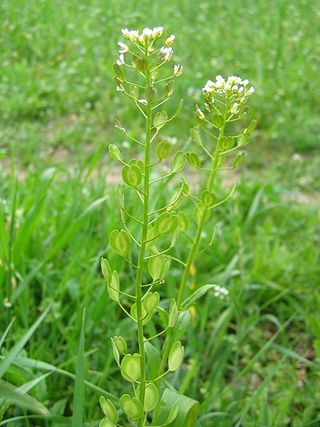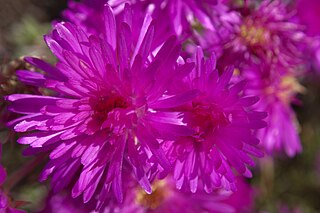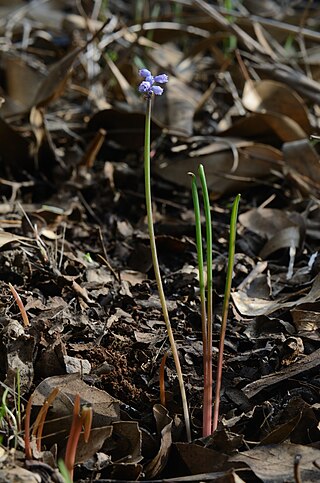
Thlaspi, or pennycress, is a genus of herbs of temperate regions of the Eurasian continent. They occur in Central and South Europe, South-West Asia and two species are endemic to China. The Thlaspi has been proven to be a hyperaccumulator of heavy metals such as zinc and cadmium and therefore may be used in phytoremediation initiatives.

Eupatorium perfoliatum, known as common boneset or just boneset, is a North American perennial plant in the family Asteraceae. It is a common native to the Eastern United States and Canada, widespread from Nova Scotia to Florida, west as far as Texas, Nebraska, the Dakotas, and Manitoba. It is also called agueweed, feverwort, or sweating-plant. It was introduced to American colonists by natives who used the plant for breaking fevers by means of heavy sweating. It is nearly always found in low, wet areas.

Callitriche truncata, the short leaved water starwort, is a species of plant in the family Plantaginaceae. They have a self-supporting growth form and simple, broad leaves. Individuals can grow to 10 cm tall.
Crepis pusilla is a species of plants in the family Asteraceae.
Erodium laciniatum is a species of flowering plant in the family Geraniaceae.
Opuntia dejecta is a species of plant in the cactus family. They are listed in cites appendix ii. Flowers are visited by the broad-billed hummingbird.

Hypecoum procumbens, the sickle-fruited hypecoum, is a species of annual herb in the family Papaveraceae. They have a self-supporting growth form and simple leaves. Individuals can grow to 40 cm tall.
Hypericum australe is a species of plant in the family Hypericaceae. Individuals can grow to 24 cm tall.

Lampranthus multiradiatus, the creeping redflush, is a species of shrub in the family Aizoaceae. They are succulent plants. They have a self-supporting growth form and simple, broad leaves.

Malephora lutea is a species of plants in the family Aizoaceae. They are succulent plants. Flowers are visited by Fidelia kobrowi.
Mesembryanthemum lancifolium is a species of plant in the family Aizoaceae. They are succulent plants.
Micromeria microphylla is a species of plants in the family Lamiaceae.

Misopates calycinum is a species of annual herb in the family Plantaginaceae. They have simple leaves.

Muscari parviflorum is a species of plants in the family Asparagaceae.

Valerianella eriocarpa is a plant species in the family Caprifoliaceae.

Orobanche caryophyllacea is a species of plant in the family Orobanchaceae.

Parietaria lusitanica is a species of plant in the family Urticaceae.

Scorzonera laciniata, also known as cutleaf vipergrass, is a species of herb in the family Asteraceae.

Polypogon viridis, the beardless rabbitsfoot grass, is a species of perennial grass in the family Poaceae. They have a self-supporting growth form and simple, broad leaves. Individuals can grow to 0.43 m. They are native to southern Europe, Macaronesia, North and East Africa, and Asia.
Romulea variicolor is a species of plant in the family Iridaceae.













